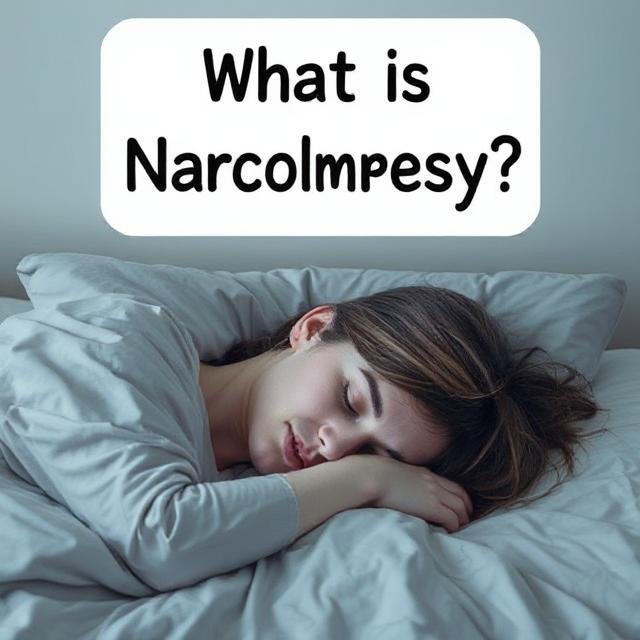Narcolepsy is a neurological sleep disorder that causes excessive daytime sleepiness and a range of sleep-related symptoms. People with narcolepsy often fall asleep suddenly — even in the middle of conversations, meals, or driving.
Key facts:
- Narcolepsy affects about 1 in 2,000 people worldwide (National Institute of Neurological Disorders and Stroke, 2023).
- Symptoms often appear between ages 10 and 30 but can occur at any age.
- Narcolepsy is a lifelong condition, though symptoms can be managed.
Types of Narcolepsy
There are two primary types of narcolepsy:
Narcolepsy Type 1 (With Cataplexy)
- Involves excessive daytime sleepiness plus cataplexy (sudden muscle weakness triggered by strong emotions like laughter or anger).
- Often linked to low levels of hypocretin, a brain chemical that helps regulate wakefulness.
Narcolepsy Type 2 (Without Cataplexy)
- Excessive daytime sleepiness but no cataplexy.
- Hypocretin levels are usually normal.
Common Symptoms of Narcolepsy
People with narcolepsy may experience some or all of these symptoms:
- Excessive Daytime Sleepiness (EDS): Overwhelming urge to sleep during the day, even after adequate nighttime sleep.
- Cataplexy: Sudden muscle weakness ranging from slight drooping of eyelids to complete body collapse, often triggered by emotions.
- Sleep Paralysis: Temporary inability to move or speak while falling asleep or waking up.
- Hypnagogic or Hypnopompic Hallucinations: Vivid dream-like experiences when falling asleep or waking.
- Disrupted Nighttime Sleep: Frequent awakenings and poor sleep quality.
These symptoms can significantly disrupt work, school, relationships, and safety.
What Causes Narcolepsy?
Narcolepsy results from a complex interplay of factors, including:
- Loss of Hypocretin (Orexin) Neurons: In Type 1 narcolepsy, many individuals have a significant loss of brain cells that produce hypocretin, a neuropeptide critical for regulating wakefulness.
- Autoimmune Factors: The immune system may mistakenly attack hypocretin-producing cells.
- Genetic Factors: Certain genetic markers (like the HLA-DQB1*06:02 gene) are strongly linked to narcolepsy.
- Brain Injuries or Infections: Rarely, narcolepsy can follow head trauma, brain tumors, or infections affecting the central nervous system.
The exact cause remains under investigation.
How Narcolepsy Is Diagnosed
Diagnosing narcolepsy involves:
- Medical History & Symptom Assessment: Discussing sleep habits, daytime sleepiness, and specific symptoms like cataplexy.
- Sleep Studies:
- Polysomnography (PSG): An overnight sleep test measuring brain waves, heart rate, and muscle activity.
- Multiple Sleep Latency Test (MSLT): Measures how quickly someone falls asleep during the day and whether they enter REM sleep rapidly.
- Hypocretin Level Testing: A spinal fluid test, sometimes used if Type 1 narcolepsy is suspected.
Because symptoms can mimic other disorders like sleep apnea, depression, or epilepsy, expert evaluation is crucial.
Treatment Options for Narcolepsy
While there’s no cure, narcolepsy is treatable. Treatment usually includes:
- Medications:
- Stimulants (e.g., modafinil, armodafinil) to reduce daytime sleepiness.
- Sodium oxybate for cataplexy and disrupted nighttime sleep.
- Antidepressants to manage cataplexy, hallucinations, or sleep paralysis.
- Lifestyle Changes:
- Scheduled daytime naps.
- Maintaining consistent sleep routines.
- Avoiding heavy meals and alcohol before bedtime.
- Using safety measures (e.g., avoiding driving when excessively sleepy).
Treatment is often tailored to each person’s specific symptoms and lifestyle.
Living with Narcolepsy
Narcolepsy can be challenging, but many people live fulfilling lives with the right support. Practical tips include:
- Educate family, friends, and employers about narcolepsy.
- Advocate for accommodations at work or school.
- Prioritize self-care and manage stress.
- Join support groups for people with narcolepsy.
Awareness and understanding help reduce stigma and improve quality of life.
When to See a Doctor
Seek medical advice if you:
- Experience overwhelming daytime sleepiness despite adequate sleep.
- Have sudden muscle weakness with strong emotions.
- Struggle with vivid hallucinations or sleep paralysis.
- Notice disrupted nighttime sleep for weeks or months.
Early diagnosis and treatment can significantly improve daily functioning.













